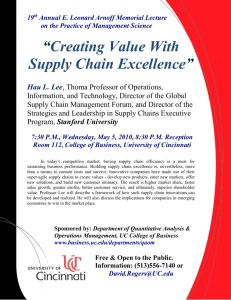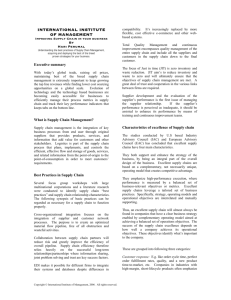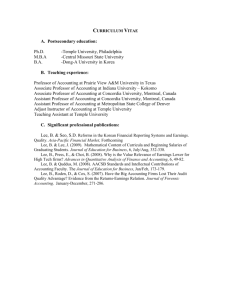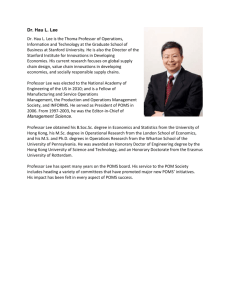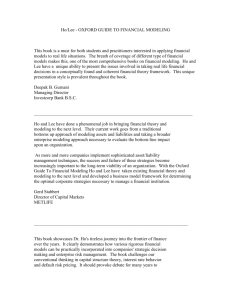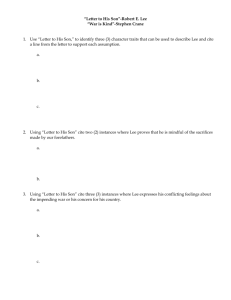The Sunrise Sector of Logistics
advertisement
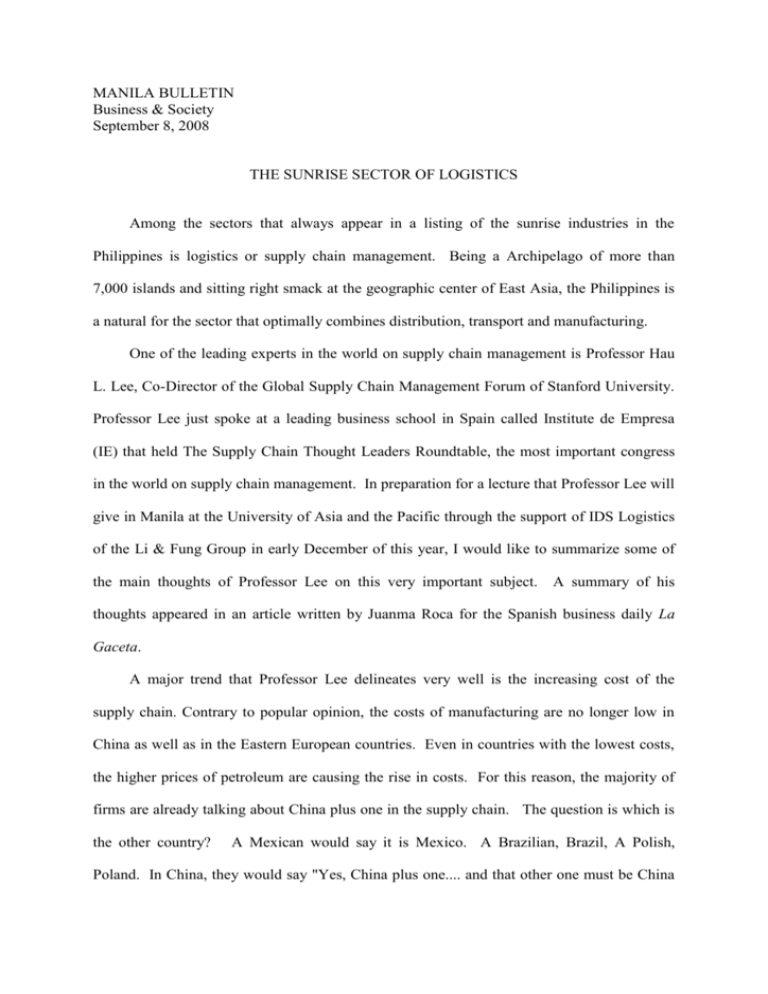
MANILA BULLETIN Business & Society September 8, 2008 THE SUNRISE SECTOR OF LOGISTICS Among the sectors that always appear in a listing of the sunrise industries in the Philippines is logistics or supply chain management. Being a Archipelago of more than 7,000 islands and sitting right smack at the geographic center of East Asia, the Philippines is a natural for the sector that optimally combines distribution, transport and manufacturing. One of the leading experts in the world on supply chain management is Professor Hau L. Lee, Co-Director of the Global Supply Chain Management Forum of Stanford University. Professor Lee just spoke at a leading business school in Spain called Institute de Empresa (IE) that held The Supply Chain Thought Leaders Roundtable, the most important congress in the world on supply chain management. In preparation for a lecture that Professor Lee will give in Manila at the University of Asia and the Pacific through the support of IDS Logistics of the Li & Fung Group in early December of this year, I would like to summarize some of the main thoughts of Professor Lee on this very important subject. A summary of his thoughts appeared in an article written by Juanma Roca for the Spanish business daily La Gaceta. A major trend that Professor Lee delineates very well is the increasing cost of the supply chain. Contrary to popular opinion, the costs of manufacturing are no longer low in China as well as in the Eastern European countries. Even in countries with the lowest costs, the higher prices of petroleum are causing the rise in costs. For this reason, the majority of firms are already talking about China plus one in the supply chain. The question is which is the other country? A Mexican would say it is Mexico. A Brazilian, Brazil, A Polish, Poland. In China, they would say "Yes, China plus one.... and that other one must be China 2 still." The Chinese think that there are still many products that have not been completely developed in China. While other countries are positioning themselves to be the next China as manufacturer and supplier. Professor Lee thinks that the best strategy is not to replace China but to attain a mix. The mix involves combining manufacturing operations in China and in, for example, Romania. One starts in China, but then uses Romania as the last stage of processing and to give higher quality to the product. Romania is closer to the European markets, making it easier to more quickly respond to last-minute changes. Thus, lower cost is achieved in China quicker response and higher quality in Romania. This is the optimum way. Diversification of suppliers is a good idea, but it should not brought to an extreme. It is no longer true that the more suppliers, the better. One, of course, should not depend only on one supplier, the dangers of which have been made obvious by such happenings as September 11, hurricanes, earthquakes, etc. Some suppliers should be required to have more than one site. For example iPod has a plant in China with 250 workers, but it has opened another factory in the Czech Republic. The relation between a company and its supplier must be closer than ever, a relation based on a deep collaboration and trust. The supplier must be considered as a stakeholder of the company. There are three levels of integration in this relationship. The first is the sharing of a great deal of information. The second is the clear identification of responsibilities, i.e., who should do what. And the third is the integration of incentives so that both sides share the risks and costs. Information Technology facilitates greatly this integration. One needs information to know what is happening in every part. Besides, technology enables the establishment of measures and metrics of productivity. To achieve greater trust with the supplier, both sides have to share common measurements of productivity. It is indispensable in arriving at these 3 measurements. Finally, technology makes it possible to establish the limits to risk to which the business is exposed. A flexible supply chain management is achieved through the complete trust that exists between the company and the supplier. There must be a 100 percent mutual confidence. The second challenge is the globalization of the supply chain. Crossing borders from the U.S. to Spain may pose no special difficulty. It may be different if the direction of globalization is from the U.S. to Colombia. There may be problems because of political realities. How many signatures are needed to cross border from the U.S. to Colombia. For this reason, there must be a relation between firms and between countries. On December 12, 2008, Professor Hau L. Lee will deliver a lecture on Supply Chain Management at the University of Asia and the Pacific in a seminar to be sponsored by IDS Logistics. Invitations will be issued to the clients and friends of IDS Logistics and the alumni of the Strategic Business Economics Program and members of the Business Economics Club of the University of Asia and the Pacific. bvillegas@uap.edu.ph. For comments, my email address is
